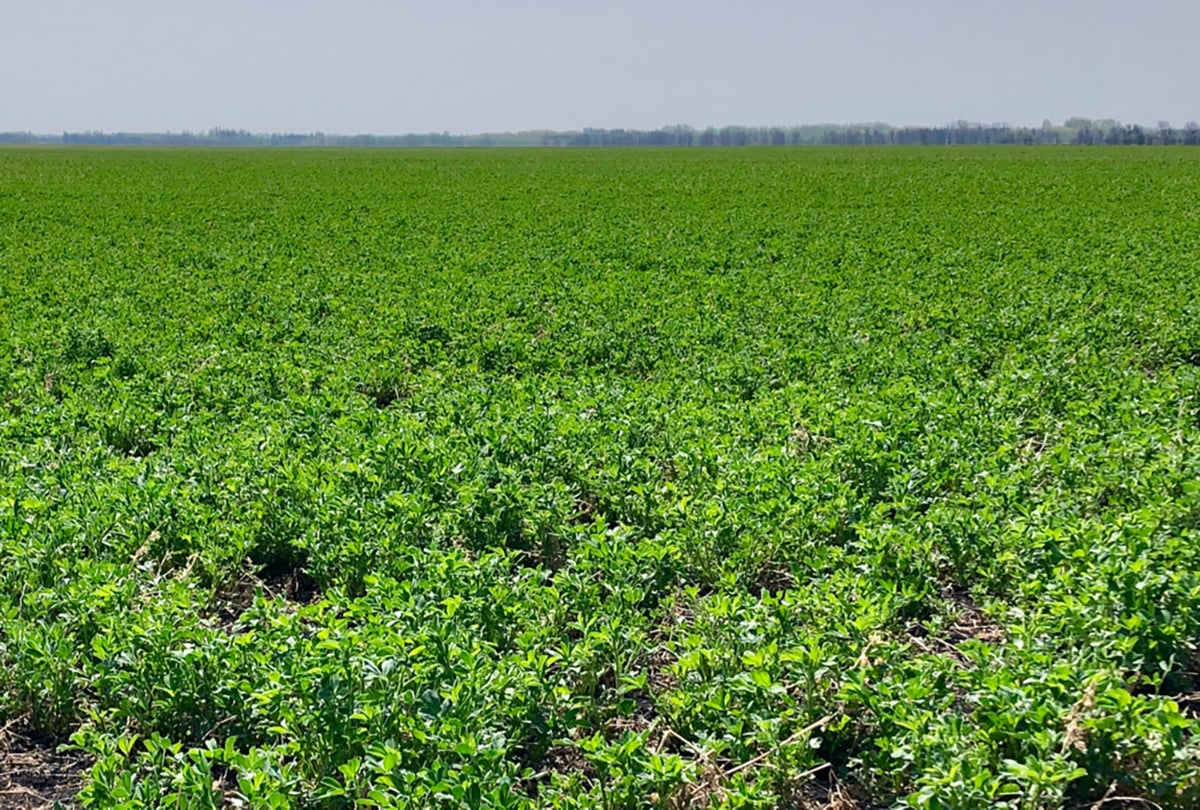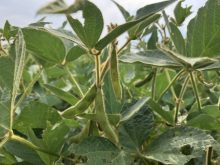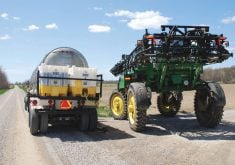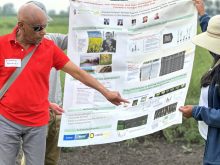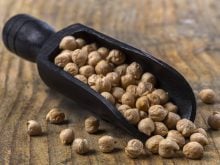Alfalfa growers might be underestimating their disease pressure — and it could be costing them.
That’s the message from Dan Undersander, a forage agronomist and professor emeritus at the University of Wisconsin. He spoke during a three-day intensive forage workshop hosted by the Canadian Forage and Grassland Association at the University of Manitoba earlier this year.
While many growers are aware of winterkill and stand thinning, they might not realize just how many diseases are chipping away at their yields — or when those issues can start.
Read Also

Fertilizer method’s link to emissions studied
A researcher says others studying greenhouse gas emissions aren’t considering how the loss of nitrogen into the atmosphere correlates with fertilizer application or if there is an impact to yield.
“If you don’t know what you’re looking for, you won’t see it,” Undersander says.
“And you’ll think that everything is just fine when it isn’t.”
Black stem
Black stem is caused by the fungus phoma medicaginis and is one of the most common alfalfa diseases across Canada’son the Prairies. It tends to show up in cool, wet conditions and often appears early in the season.
According to the Manitoba Agriculture website, the disease can be identified in early spring by numerous dark spots on the lower leaves, petioles and stems. These may expand into large black areas. Infected leaves often turn yellow and fall prematurely, and lesions that girdle the stem can cause wilting above the damage.
“If it causes complete girdling of the stem, then the stems will die,” Undersander says.
“If you have enough of that, then your plant will die.”
Early cutting can help reduce losses, as can rotating with non-legumes for a few years before reseeding alfalfa.
Crown rot, root rots
A wide range of fungi, including fusarium, rhizoctonia and phoma, cause crown and root rot, especially in older stands or those affected by winter injury. Symptoms include stunted growth, yellowing and poor vigour.
“If crown rot is less than 50 per cent of the crown’s diameter, it’s probably worth keeping the stand,” Undersander says.
“But if it exceeds 50 per cent, you should think about turning it over because there’s a good chance it won’t survive.”
Winter crown rot, also known as snow mould, is another threat to alfalfa and other legumes.
It’s caused by several soil-borne fungi that are most active during late fall and early spring when plants are dormant and soil temperatures are near freezing. Once the soil warms above 0 C, these fungi become inactive, and alfalfa is no longer at risk for this disease.
Aphanomyces
Aphanomyces is another type of root rot, caused by the oomycete aphanomyces euteiches, and has become a significant disease in alfalfa production, particularly in wet or poorly drained soils.
“If the seedlings are coming up and the cotyledon dies, but the seedling stays erect — that’s probably aphanomyces,” Undersander says.
It often appears on slopes rather than in low-lying areas, and its biggest effect is on root development.
Undersander says aphanomyces causes root pruning, which weakens the alfalfa’s root system. As a result, the plants become less competitive, creating opportunities for weeds to invade the field.
Verticillium wilt
This cold-weather vascular disease was introduced from Europe and has been causing problems in British Columbia since the 1970s.
It was first detected on the Prairies in 1998, in Manitoba, but has since spread to Saskatchewan and Alberta.
Undersander says it can be identified by what he calls a “thumbprint” on the leaf — irregular, pale or yellowish patches that appear on the leaves, which can resemble the shape or impression of a thumb.
“This is a disease that causes dead leaves on a green stem,” he says.
“It causes problems because it’s attacking the vascular system.”
Symptoms are worst in spring and fall. Infected stands may die out in a few years, especially under irrigation. Rotating with cereals or grasses — and avoiding potatoes, sunflowers and sweet clover — is recommended.
Common leaf spot
Caused by the fungus pseudopeziza trifolii, this disease shows up as tiny black or brown circular spots on leaflets, with a lighter brown raised disc in the centre. As the infection spreads, leaves will yellow and drop early, reducing yield potential. It thrives in moist weather and overwinters in crop residue.
Manitoba Agriculture recommends cutting before leaves begin to fall, and using resistant varieties such as Rambler.
Downy mildew
This foliar disease shows up as pale blotches on the top of leaves and a violet, downy growth underneath. Plants may appear bunched or twisted at the top. It’s most active in spring and fall under wet, humid conditions, but usually doesn’t cause serious damage.
Undersander says downy mildew can be a concern in both spring and fall.
“Depending on the time of year, different organisms can be a problem,” he says.
According to Manitoba Agriculture, resistant cultivars such as Algonquin can be used for control, and rotating with cereals or grasses can help reduce infection.
Phytophthora
Phytophthora root rot is especially problematic in poorly drained areas and spreads through standing water in warm weather.
Even if phytophthora doesn’t kill the plant right away, Undersander says, it can severely damage the root. The plant may appear healthy for a while, but when dry conditions hit, it often can’t access enough moisture and will die as a result. He advises digging about six inches to check root health.
“You might keep the alfalfa for the current season, but if the root is rotted off, you should plan on turning it over,” he says.
Anthracnose
Though it’s often associated with lentils and dry beans, anthracnose can also be a yield thief in alfalfa — and it frequently goes unnoticed, Undersander says. The disease is identifiable by diamond-shaped lesions on the stem and sudden dieback at the top of the plant.
“There has been good resistance to it,” he says.
“And we should think about taking advantage of that because it will cause as much as a 20 or 30 per cent yield loss if you’re not paying attention.”
Timing matters
The appearance and impact of alfalfa diseases often depend on both the age of the stand and the time of year. Diseases such as phytophthora, pythium and black stem typically show up in new seedings, while bacterial wilt, fusarium wilt, crown rot and verticillium wilt are more common in older stands.
“You wouldn’t expect to see them in the first year or two, but you would maybe see them in the third or fourth year,” Undersander says.
Seasonal conditions also influence disease expression.
Some pathogens thrive in cool, wet weather: downy mildew and verticillium wilt, for example, are often seen in spring and fall. Others, such as spring black stem and pythium, emerge early in the season, while summer black stem appears later.
Understanding when a disease is likely to appear can help with diagnosis and inform decisions about cutting, rotation and stand management.
Management tips
Undersander offers several general tips for alfalfa growers aiming to manage disease risk.
He recommends starting with good-quality seed and avoiding planting alfalfa after another legume.
Where possible, he says, farmers should stick to planting in well-drained fields to help prevent root rot diseases and avoid wet spots that can foster pathogen growth.
Maintaining good pH and nutrient levels is important, he adds, because vigorous plants are more disease-resistant.
He suggests controlling insects because they also introduce pathogens to a crop.
Farmers should also mow new seedlings before old stands, and try to mow clean fields before infected ones, to reduce disease spread.
“Wait till the dew is off before mowing,” Undersander says.
“I don’t recommend expecting all the dew to be gone, but at least a high portion of it.”




